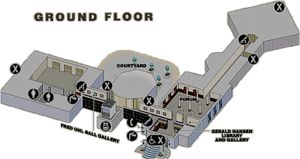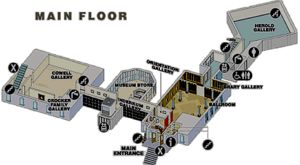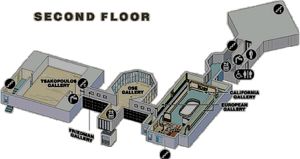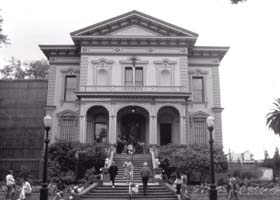 Crocker
Art Museum Investigative Report
Crocker
Art Museum Investigative Report
Back to Paranormal Travel Guide
 Crocker
Art Museum Investigative Report
Crocker
Art Museum Investigative Report
![]()
Date: October 18, 2002. 11:00 AM – 2:30 PM.
Location: Crocker Art Museum, 216 O Street, Sacramento, California 95814. Phone: 916-264-5423.
Participants: Dennis William Hauck (Paranormal Researcher and Author); Jason Lindo (Paranormal Investigator and Sensitive); Erika Jackson (Crocker Museum Public Programs Coordinator)
History of the Location
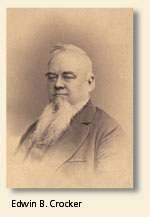 The property
and existing buildings on the corner of Third and O streets in Sacramento were
purchased by Judge Edwin B. Crocker in 1868. The next year, he suffered a stroke
that left him partially paralyzed for the rest of his life. However, he worked
closely with architect Seth Babson to redesign and remodel the former B. F.
Hastings home into an Italianate mansion, and behind it they constructed a grand
gallery building annexed to the mansion. The Crockers moved into their mansion
in the fall of 1872. The gallery building was completed the following year and
incorporated a bowling alley, skating rink, and billiards room on the ground
floor. A natural history museum (now the Ballroom) and the Library were on the
main floor, while art gallery space was provided on the second floor.
The property
and existing buildings on the corner of Third and O streets in Sacramento were
purchased by Judge Edwin B. Crocker in 1868. The next year, he suffered a stroke
that left him partially paralyzed for the rest of his life. However, he worked
closely with architect Seth Babson to redesign and remodel the former B. F.
Hastings home into an Italianate mansion, and behind it they constructed a grand
gallery building annexed to the mansion. The Crockers moved into their mansion
in the fall of 1872. The gallery building was completed the following year and
incorporated a bowling alley, skating rink, and billiards room on the ground
floor. A natural history museum (now the Ballroom) and the Library were on the
main floor, while art gallery space was provided on the second floor.
The gallery space was created to house the Crockers' collection of paintings, one of the largest private collections in the country at that time. The family acquired over 700 paintings in Europe during their Grand Tour of 1869 - 1871. They also purchased 1,300 old master drawings, now considered one of the finest such collections in the world. The Crockers also acquired numerous paintings by then-contemporary California artists, including Charles Nahl, Norton Bush, Thomas Hill, William Keith, and William Hahn. The private collection was opened frequently for public benefit, and the family planned to eventually create a major public museum.
In 1874, the Crocker’s eldest
daughter, Kate, died in the house just a few months after getting married. Judge
Crocker died the following year, and his wife (Margaret Eleanor Crocker) took
over the family philanthropies. Margaret was a spiritualist and interested in
spiritual phenomena and had a deep commitment to the family art collection. In
May 1885, she presented the gallery building and its contents to the
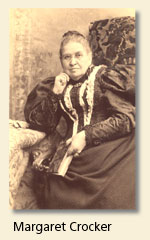 city of
Sacramento. Artist William F. Jackson (1850-1936) was hired as the first Gallery
Director. In keeping with their ambitious plans, they also instigated a lecture
program; opened the Sacramento School of Design on the main floor of the Gallery
building; sponsored exhibitions; and appointed Margaret Crocker and her
daughters (Mary Walker, Jennie Fassett, and Amy Ashe) as permanent members of
the gallery museum. In the early 1900s, the Crocker mansion was turned into
Peniel Rescue Mission for unwed mothers and their children. Finally, in 1911,
Jennie gave the family home to the city as an additional museum piece. Margaret
died in 1901 and her ashes are buried in the family plot in the Old City
Cemetery. Nonetheless, there are indications she never really relinquished her
“permanent membership” in the museum.
city of
Sacramento. Artist William F. Jackson (1850-1936) was hired as the first Gallery
Director. In keeping with their ambitious plans, they also instigated a lecture
program; opened the Sacramento School of Design on the main floor of the Gallery
building; sponsored exhibitions; and appointed Margaret Crocker and her
daughters (Mary Walker, Jennie Fassett, and Amy Ashe) as permanent members of
the gallery museum. In the early 1900s, the Crocker mansion was turned into
Peniel Rescue Mission for unwed mothers and their children. Finally, in 1911,
Jennie gave the family home to the city as an additional museum piece. Margaret
died in 1901 and her ashes are buried in the family plot in the Old City
Cemetery. Nonetheless, there are indications she never really relinquished her
“permanent membership” in the museum.
The Investigation
My primary objective in investigating paranormal phenomena is to document the activity as best I can. To facilitate that, I normally work with psychically sensitive individuals, who serve both as guides and “triggers” for manifestations of paranormal energy. Traditionally, fluctuations in the electromagnetic field (the “EMF”) at a site seem to accompany paranormal events. The EMF is the invisible field of energy that emanates from electrical and magnetic circuits. For instance, if you bring a compass in the vicinity of a running motor, you will notice significant deviations in the compass reading. At genuine hauntings, the EMF is so strong that static electricity in the air increases noticeably, and security alarms sound and circuit breakers trip for no apparent reason. Sometimes the EMF increases so dramatically that appliances turn themselves on and off, motors overload, or light bulbs glow white and burn out. Therefore, at the beginning of an investigation, it is important to determine the normal background EMF readings for the area.
The investigation began on the second floor in the East Wing of the European gallery. This section houses the original Crocker family collection and is connected to the Crocker mansion by a long corridor. I took readings to establish the normal background electromagnetic field (EMF) for the room. Jason immediately felt a presence, as if we were being followed, as we ascended the staircase and entered the East Wing through the north archway. He got the strong impression of “a woman making her normal rounds – but she was disturbed because she liked routines and something had been interrupted.” We later learned that a painting that hung in that area since 1998 (Allegory of Painting by Gerrit van Honthorst) had been moved and a new acquisition (Dordrecht Harbor by Frank Myers Boggs) hung in its place. The EMF in front of this new acquisition was very strong and averaged about 90 times the normal EMF for the area. This field extended to the archway and increased the closer one got to the frame of the painting, and then ended abruptly beyond the painting. There were no electrical circuits in the area to explain the EMF effects, and this kind of focused EMF is indicative of paranormal energy.
When pressed for more details on the presence, Jason described the female as particularly attracted to the East Wing and concerned about its preservation. She definitely “liked things kept in their place.” The names he was getting were “Maggie,” “Eleanor,” or “Emily,” but he admitted being hesitant to reveal “Maggie” since “Margaret” was Mrs. Crocker’s name, and he did not want to appear to be obvious. He did not realize at the time that “Eleanor” was Margaret’s middle name. We also found out later, after talking with the former archivist at the museum, that his description of Margaret’s personality was very accurate. She was a woman with definite ideas on how the museum should be run, where certain paintings should be displayed, and how important it was to operate under a set routine.
Further confirmation of paranormal activity in the East Wing came from staff members. The alarms in the area, which are triggered by changes in temperature and movement, often go off for no apparent reason, especially between midnight and 3:00 AM. Alarm company technicians investigating the false alarms have yet to find any technical fault in the system. Intense cold spots and the feeling of being followed by an invisible presence have been reported by security personnel on their rounds late at night. Unexplainable sounds have also been reported, such as invisible doors closing and the disembodied footsteps of a woman. One male guard reported brushing against an invisible person standing in the middle of the hall and someone following him on his rounds. Once, a female guard reported going from the California Room into the East Wing and seeing the room as it must have existed in the nineteenth century. For several seconds, the room was furnished with different paintings, which were protected by a 3-foot-deep guard railing that no longer exists.
The West Wing of the European Gallery exhibited no significant paranormal energy. There were repairs underway in that area for water damage in the ceiling and the hall contained fewer paintings than normal. There were no EMF spikes in the West Wing. Two electrical panels were located at the south end of the second floor, where the two wings converge in a u-shaped corridor. While the EMF near these panels was very high, the field was completely contained within a 15-inch area around the panels.
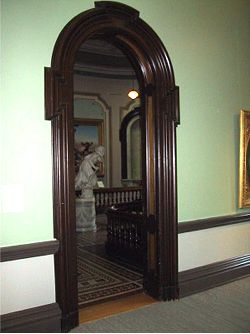 In the California
Room, which is nestled between the East Wing and the West Wing, a unique and
significant EMF pattern was detected. It was originally noticed by Jason, who
described an elongated concentration of energy in the south section of the room.
After mapping this concentrated pool of energy, it was discovered that it was
one of eight such looping patterns, which emanated from a center located at the
bench in the area. This 8-petaled rose-shaped pattern is known among paranormal
researchers as the “heart of the house” and has been detected in many old
mansions. The dominant feature of this area is a huge painting (Thomas Hill’s
The Great Canyon of the Sierra – Yosemite), which nearly fills the entire
south wall of the California Room. According to Erika Jackson, this is one of
the museum’s “signature pieces” that has hung in this same spot since 1873 and
has never left the building. The striking painting is the pride of the Crocker’s
collection, and it attracts many visitors, who sit for hours on the bench in
front of it in quiet veneration. There can be no doubt that this area is the
true heart of the Crocker Museum.
In the California
Room, which is nestled between the East Wing and the West Wing, a unique and
significant EMF pattern was detected. It was originally noticed by Jason, who
described an elongated concentration of energy in the south section of the room.
After mapping this concentrated pool of energy, it was discovered that it was
one of eight such looping patterns, which emanated from a center located at the
bench in the area. This 8-petaled rose-shaped pattern is known among paranormal
researchers as the “heart of the house” and has been detected in many old
mansions. The dominant feature of this area is a huge painting (Thomas Hill’s
The Great Canyon of the Sierra – Yosemite), which nearly fills the entire
south wall of the California Room. According to Erika Jackson, this is one of
the museum’s “signature pieces” that has hung in this same spot since 1873 and
has never left the building. The striking painting is the pride of the Crocker’s
collection, and it attracts many visitors, who sit for hours on the bench in
front of it in quiet veneration. There can be no doubt that this area is the
true heart of the Crocker Museum.
The Mansion Wing, which is an annex to the original Crocker home from the East Wing of the European Gallery, also seems to be under Margaret Crocker’s influence. The area exhibits a kind of “tension in time.” Not long ago, a group of visitors got into the elevator and pushed it to go to the ground floor. Instead of moving, the elevator doors opened up again to reveal a new scene in which the gallery appeared completely different from how they had left it. It was almost as if they were looking into a different time frame. They pushed the button again, and this time the elevator took them to the desired destination. In 1989, during renovations before the Mansion Wing was opened to the public, a security guard encountered something that frightened him so badly he ran out of the building and never returned.
There is further evidence that Margaret is letting her preferences known in this area. In July 2002, a larger than life-size contemporary wooden sculpture of a woman by Robert Brady inexplicably fell over and was damaged. That same month, a sculpture of a ceramic monkey on a hat in the Tony Natsoulas exhibit fell off and broke. Disturbances have also been reported nearby in the Ose Gallery, just off the annex on the second floor. On September 29 at 3:09 AM, the security alarms there were tripped for no apparent reason. Visitors have admitted to feeling an intense spiritual energy in the Tsakopoulos Gallery on that same floor. The gallery is dominated by Portrait of My Father, a large work by Stephen Kaltenbach (painted between 1972 and 1979) that depicts the moment of his father’s death. This painting is one of the museum’s recent acquisitions.
The South Wing of the second floor is a very modern section containing the museum offices. The circular floorplan consists of a ring of staff member’s cubicles. Jason detected a strong barrier of energy at the entrance to the offices, as if this were where the old staid museum confronts the bustling activity of the modern world. He felt that some of the presences in the older parts of the museum were actually attracted to this area of life and activity. Indeed, several workers have reported unexplainable knocking sounds and door rattling, as if some invisible person were trying to get in.
The Crocker Family Gallery, on the ground floor, contains original furnishings from the mansion and is dominated by portrait of Margaret Eleanor Crocker. While Jason sensed her “signature” in the room, her presence was not as energetic as it was in the East Wing. In the Library on the same floor, Jason detected the presence of Judge Crocker’s spirit. He felt a similar presence in the museum director’s office, and it was later discovered that both rooms contain the judge’s personal papers and books. The general impression was that the judge was an intellectual man not as emotionally connected to the mansion as was his wife.
The Ballroom on the main floor is directly underneath the California Room. It did not become a Ballroom initially and was previously used for a wide variety of purposes. Several staff members have reported the distinctive sounds of someone running around in this area when no one is there. Sometimes the sounds come from the Library as well. The area under the front porch on the ground floor in the Mansion Wing was notable for its complete lack of any EMF readings. In a way, the porch behaves like a giant insulator, completely shielding outside energies. There is no explanation for this phenomenon. The nearby staircase entrance serves as an entry to this shielded space. Jason detected what felt like a “sheet of energy” at the entrance to the stairway.
A concentration of EMF energy was detected deep in a closet in the foyer at the main entrance to the museum. There was no obvious explanation for the readings, although in 1925, a deranged man ambushed guests entering the museum. The bullet hole in the door next to the coat rack is evidence of that incident.
Another location of frenzied spiritual energy is downstairs near the restrooms off the Fred Uhl Ball Gallery, which is the ground level annex to the original mansion. Jason was especially sensitive to the powerful and chaotic energy here. The entire gallery is considered an “unfinished” area by staff members, who have never really been able to decide how to utilize it. The area seems to constantly be in flux. There was a ladder leaning against the wall while we were there, and the gallery had a feeling of being “under construction” although nothing like that was happening. EMF readings also swung widely between 10 to 80 times the expected EMF level, although the low ceiling did have several fluorescent fixtures with transformers. One possible paranormal explanation is that the area near the restrooms, which are closest to the mansion basement, was used as a clinic or delivery room when the mansion served as a home for unwed mothers.
Conclusion
To summarize, our investigation found both physical and psychical evidence for the reported hauntings at the Crocker Museum. Much of the activity centers around the spirit of Margaret Eleanor Crocker, although other sources include impressions on the building itself and the spiritual energy emanating from some of the artwork it contains. Many visitors and staff have commented on the elevating spiritual energy at the Crocker and how just walking its halls is a refreshing escape from the tensions of the modern world. People come to sit for hours meditating on the wonderful art that the Crockers left for everyone to enjoy. Overall, the energy is very positive and nurturing, although sometimes perhaps a little overprotective. It will be interesting to see how Margaret Crocker reacts to a new exhibition of contemporary art planned to run from December to February at the museum. The exhibit features nontraditional interpretations and some nudity.
